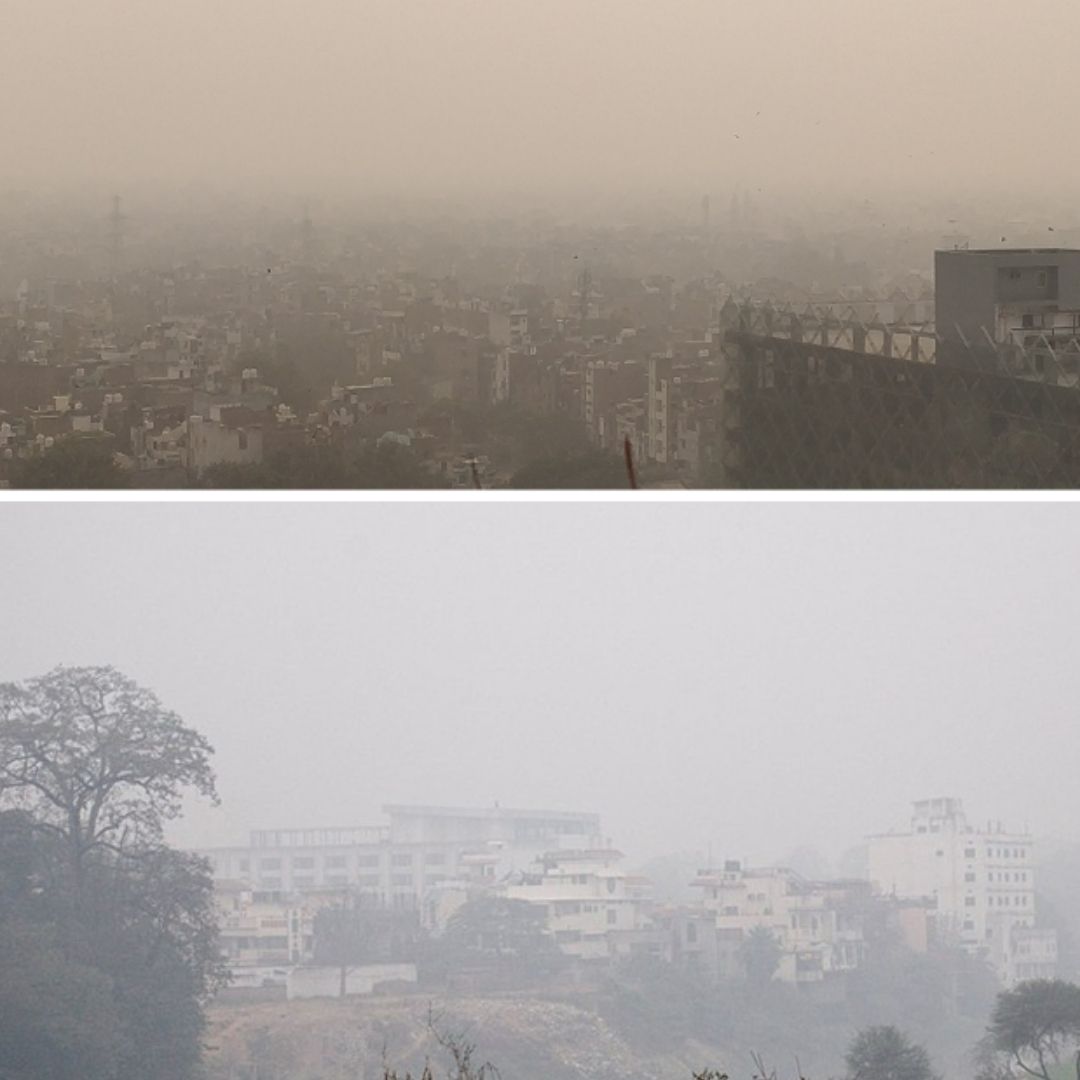India Has 9 Out Of 10 World's Most Polluted Cities, But Few Air Quality Monitors Than Other Populated Nations
Writer: Tashafi Nazir
For most people, journalism sounds hectic and chaotic. For her, it's a passion she has been chasing for years. With an extensive media background, Tashafi believes in putting efforts on presenting a simple incident in the most interesting way.
India, 18 Dec 2021 8:30 AM GMT | Updated 20 Dec 2021 10:21 AM GMT
Editor : Palak Agrawal |
Palak a journalism graduate believes in simplifying the complicated and writing about the extraordinary lives of ordinary people. She calls herself a " hodophile" or in layman words- a person who loves to travel.
Creatives : Tashafi Nazir
For most people, journalism sounds hectic and chaotic. For her, it's a passion she has been chasing for years. With an extensive media background, Tashafi believes in putting efforts on presenting a simple incident in the most interesting way.
Most of the air quality monitors are concentrated in urban areas. This, experts say, prevents India from knowing the true extent, scale and geographical spread of various pollutants, and limits the government's ability for preventive public health measures.
India has nine of the 10 most polluted cities worldwide, but it needs 1,600 to 4,000 air quality monitors owing to its size, population and rising pollution levels. As of September 2021, India has only 804 air quality monitors, mostly in urban areas.
Experts said that this is the reason why the country is unable to know the true extent, scale and geographical spread of different pollutants and limits the government's ability for preventive public health measures.Most of the air quality monitors are concentrated in urban areas. This, experts say, prevents India from knowing the true extent, scale and geographical spread of various pollutants, and limits the government's ability for preventive public health measures.
With 200 particulate matter (PM) 2.5 monitoring sites in operation from 2010-2016, India's air quality monitor density (nearly 0.14 monitors per million people), is below China
(1.2), the US (3.4), Japan (0.5) and Brazil (1.8) respectively, according to IndiaSpend.
As a consequence, India does not exactly know the spread of pollutants, including nitrous dioxide (NO2), sulphur dioxide (SO2), respirable PM 10, the finer particulate matter or PM 2.5, lead, carbon monoxide (CO) and ammonia. As per the World Health Organisation, chronic exposure to these pollutants contributes largely to the risk of developing cardiovascular and respiratory diseases, and in extreme cases lung cancer.
Since existing air quality monitors are concentrated in cities, health and environmental authorities are unable to assess the level of air pollution in villages due to fuelwood, biomass, spraying of pesticides and stubble burning.
Need For Real-Tme Air Quality Monitoring
Ambient air quality is monitored by observing pollutants like NO2, SO2, PM 10, PM 2.5, lead, CO, and ammonia. Currently, India's clean air programme has set a tentative national target of 20-30 per cent reduction of air pollution in 132 non-attainment cities by 2024. These cities did not meet the national ambient air quality standards (NAAQS) and are required to formulate city-specific action plans to reduce air pollution. While the focus is on the most-polluted cities, rural and semi-urban areas are not being fully monitored.
In India, air quality is traditionally monitored using manual readings, and experts use data from 804 stations to ambient air quality. Even after the real-time monitors were introduced, the Central Pollution Control Board (CPCB) continues to use data from manual monitors to report compliance with air quality standards.
There are total 261 real-time monitors whose data are updated on the central database and it is part of the National Air Quality Monitoring Programme (NAMP). According to 2020 Centre for Science and Environment (CSE) report, its data is stored and treated separately as CPCB has not established a method of equivalence between the two monitoring techniques.
In the manual system, the monitoring of pollutants is carried out for 24 hours with a frequency of twice a week, whereas real-time monitors measure pollutants constantly. Data from real-time monitors are only included in calculating a location's daily AQI (air quality index).
"Manual monitoring protocol requires readings from 104 days yearly but for some stations, data was recorded for just 50-75 days," Anumita Roychowdhury, executive director at CSE and the report's author, said.
Experts said that manual monitoring is a monotonous procedure and readings once or twice a week are not beneficial for daily understanding of air quality. They also suggested that data from real-time monitors to be used for ascertaining long-term trends.
Requirement Of 1,500 Air Quality Monitoring Stations
The minimum number of stations to monitor suspended particulate matter with a population of less than 100,000 is four. As per CPCB guidelines for ambient air quality monitoring released in 2003, the minimum number is four for NO2, three for SO2, one for CO2, while the number of monitors required increases with growing population.
The number of sampling sites depends on the area size to be covered, data requirements related to monitoring, variability of pollutant concentration, a pollutant to be monitored and population figures which can be used as indicators of air quality deterioration and health implications.
India's six megacities (Delhi, Mumbai, Chennai, Bengaluru, Kolkata and Hyderabad) need at least 23 to 44 air quality monitoring stations. In contrast, the existing stations range between nine and 12, excluding Delhi.
"Over 33 per cent of the real-time monitors are concentrated in Delhi-NCR. The national capital alone has invested over Rs 100 crore to set up 38 stations over time," said the CSE report. Station density is inferior in several states, including Manipur and Arunachal Pradesh.
According to another paper titled Monitoring particulate matter in India' published in Springer journal in 2019, only two to five years of data are available now. Manipur, with a population of 2.7 million, has only one monitoring station in 2021 and Arunachal Pradesh has just two whereas it has a population of 1.25 million.
Using CPCB criteria, an average city of with more than one million residents needs nearly 25 monitoring stations, and if this number is extrapolated across 60 million cities, a total of approximately 1,500 stations would be required, as per the journal.
The Cost Of Measuring Pollutants
To address the data gaps in monitoring pollutants, India will need 1,600-4,000 monitors (1.2-3 monitors per million people).
The average cost of a monitoring station is nearly Rs 1 crore with around 10 per cent for annual maintenance costs. This would require an initial investment of Rs 3,000 crore to set up 1,500 stations.
India has set aside a budget of Rs 470 crore to control pollution in the financial year 2021-22, including funding for its ambitious National Clean Air Programme.
Rural Areas To Be Monitored
The NCAP report pointed out the grave problem of air pollution in rural areas and proposed setting up 75 stations in rural areas.
Rural areas suffer from outdoor air pollution as well as indoor air pollution. Significant sources of outdoor air pollution are the indiscriminate use of insecticides/pesticides sprays and the burning of wheat and paddy straw. Atmospheric ozone concentration has been observed higher in rural areas than urban areas, the report stated.
Alternatives To Expensive Monitors
According to Sunil Dahiya, analyst, Centre for Research on Energy and Clean Air, procuring new air quality monitors is costly and consumes a lot of time. Apart from government monitors, the industries have also set up monitors. If the data is coupled with government data, it could give much more granular information for pollution across India. It will also save the money to set up new stations.
Another alternative to costly monitors could be low-cost sensors. These sensors offer an opportunity to generate high-resolution data at a low price, with deployment and access limitations. However, they are not long-term, does not provide accurate data, but efforts are underway to improve precision in such sensors.
Also Read: IIT Delhi Develops RT-PCR-Based Assay To Detect Omicron Variant Within 90 Minutes
 All section
All section















